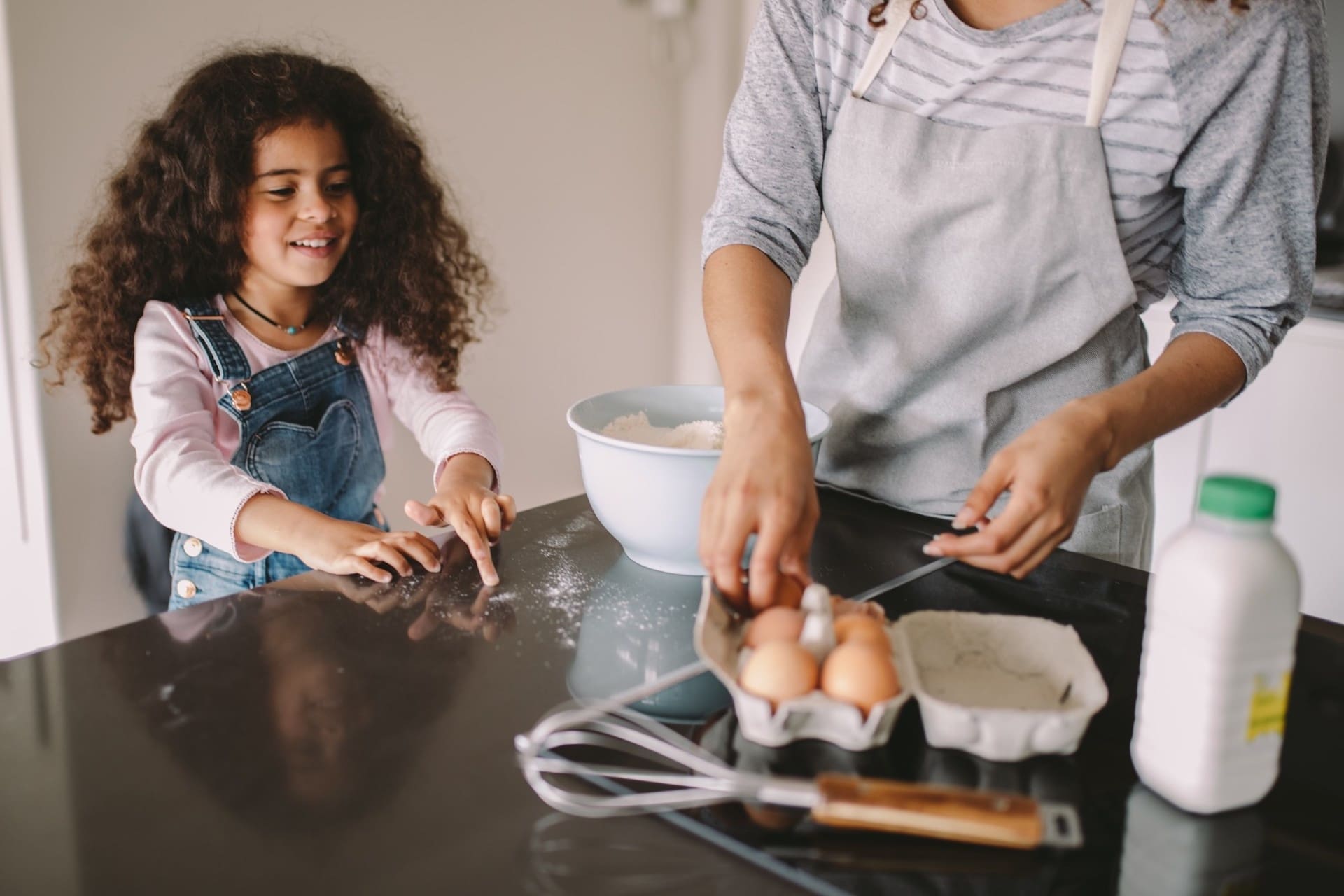10 fun Montessori-inspired ways to introduce cooking to your child

4. Put them in charge of snacks.
Table of Contents
- 1. Set them up for success with the right tools
- 2. Talk about safety…then back away
- 3. Introduce chopping
- 4. Put them in charge of snacks
- 5. Start a kitchen herb garden
- 6. Invite them to help with dinner
- 7. Introduce specialty tools
- 8. Let them measure & mix
- 9. Allow them to choose the activity
- 10. Set up a mud kitchen
If you visit any Montessori classroom for young children, you’ll likely see a few children in aprons working to prepare food. Teaching children to cook goes far beyond giving them culinary skills—it gives them a sense of pride and independence. There is something so satisfying for a child, who is usually the one being served, to be able to prepare something on their own and serve it to someone else.
Here are 10 fun and simple ways to introduce cooking to your child:
1. Set them up for success with the right tools
There are a few basic things children need to be successful in the kitchen. First, they need a work station that they can easily reach. This can be a small table by the kitchen or you can use a kitchen helper to allow them to reach the counter.
They will also need a few child-sized tools like a wavy chopper, apron, cutting board, small wooden spoon and whisk. But don’t feel like you need to buy everything at once, mama. You can add to their kitchen tool collection over time.
2. Talk about safety…then back away
When you first introduce things like a wavy chopper, talk briefly about safety and any rules you might have like keeping the work in the kitchen and keeping tools out of mouths, etc.
Then make sure not to hover as your child works. You can supervise of course, but they won’t be able to focus or do their best work if you’re standing over them.
3. Introduce chopping
Isolating skills like chopping makes them easier for children to learn.
Show them how to use their wavy chopper, starting with something easy to chop like a cucumber. For round things like cucumbers, it can be easier for the child if you first cut the vegetable lengthwise so that it has a flat side they can put on their cutting board.
Make sure to give them a little bowl for the pieces they’re slicing. Young children do better if it’s really organized and they know where to put things.
4. Put them in charge of snacks
Children in Montessori schools almost always have self-serve snacks, where they either make their own snack or select a portion of food from a tray and put it on their own plate. They also generally wash the dishes when they’re done.
While you likely won’t have a big tray of food from which your child can serve themselves, they can easily choose a pre-set number of crackers from a box, serve themselves a serving of fruit from a bowl in the fridge or chop carrots to eat with hummus.
5. Start a kitchen herb garden
Showing your child the process of cooking from start to finish.If you’re not much of a gardener, you can simply choose a couple of herbs and keep them in pots. Invite your child to water the plants and pick the leaves when you need them. Tearing herb leaves is also a great fine motor activity and one that even small toddlers can do!
6. Invite them to help with dinner
Beyond gaining cooking skills, making a meal together really helps small children feel like they’re important and a contributing part of the family.
It also goes a long way toward solving the fiasco of trying to cook dinner with a small child who wants your attention. The good news is that almost all meals have some aspect that children can help with, even if it’s simply tearing lettuce for a salad or chopping some vegetables.
Bonus: Your child is more likely to eat something if they helped make it!
7. Introduce specialty tools
I’m not always big on one-use kitchen items for myself, but there are a few small and inexpensive kitchen tools that really help make cooking doable (and fun!) for kids. Things like an egg slicer (which is great for strawberries as well), a cherry pitter, and an apple slicer keep things fun and interesting for your child and let them practice with different foods.
8. Let them measure & mix
Measuring and mixing is one of the simplest ways kids can help in the kitchen.
Choose a recipe that isn’t super precise, like soup or granola, and show your child how to use measuring spoons and cups to measure the ingredients.
If you’re worried they’ll dump in way too much, have them dump things into a separate bowl and then add to the main mixture so the whole recipe isn’t ruined.
9. Allow them to choose the activity
This may be the hardest part for parents. Do you really want to deal with the mess of letting your child practice their budding culinary skills on their own whenever they wish?
They key is to set your child up for success. If they’re only 3 years old, don’t provide an array of options that are likely to make a huge mess. Instead, choose one simple activity like carrot slicing or cherry pitting and put everything they need on a low shelf where they can get it themselves.
Make sure to show them the whole process including washing hands before and after and how to clean up. Make sure to specify that they should clean up the whole activity before eating the food they’ve prepared. This helps ward off the clean-up battle.
Once they’ve mastered the activity, including clean up, you can add another option. This is a great way to control the mess factor without hovering over your child, which totally ruins the fun!
Here are some potential activities you might put on your child’s shelf to do independently, and what you might want to have on the tray:
Clementine peeling
What you’ll need: a tray, small bowl for peel, small bowl or plate for clementine slices.
Banana peeling & slicing
What you’ll need: a tray, bowl for peel, banana slicer or wavy chopper, cutting board and a small bowl or plate for banana slices.
Carrot cutting
What you’ll need: a small basin and scrub brush for scrubbing carrots, small sponge for spills, small carrot peeler and bowl for scraps, wavy chopper, cutting board and a small bowl or plate for carrot slices.
Strawberry slicing
What you’ll need: a cutting board, egg slicer or wavy chopper and a small bowl or plate for slices.
Note: It helps a lot if you cut off the green tops ahead of time.
Egg peeling & slicing
What you’ll need: a small bowl for peels, cutting board, egg slicer and a small bowl or plate for slices.
Cheese grating
What you’ll need: a cutting board, mini grater and a small bowl for cheese.
Peanut butter spreading
What you’ll need: a small container with lid containing a teaspoon of peanut butter, spreading knife, cutting board, crackers to spread peanut butter on and a small plate for the crackers.
Cherry pitting
What you’ll need: a cutting board, cherry pitter, small bowl for pits and a small bowl for cherries.
Making trail mix
What you’ll need: several lidded containers with different nuts, cereals, dried fruit, a scoop or small measuring cup and a bowl for the trail mix.
10. Set up a mud kitchen
Play is such an important part of how children process experiences and new information. If you start cooking with your child and then set up a simple mud kitchen outside, you will see them practicing their new skills and coming up with all sorts of creative dishes on their own.
Remember: This doesn’t have to be fancy. It can be as simple as some play pots and pans and old kitchen utensils with some sand or dirt nearby. It’s great if you have a water source your child can use, but this can simply be filling up a large basin or water table using the hose.
When it comes to introducing cooking to your child, the important thing is to follow their interests and skills. Introduce one thing at a time, don’t freak out about the mess, and let your child lead the way. Bon appétit!





































